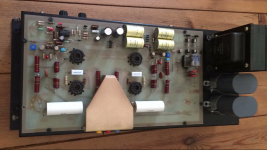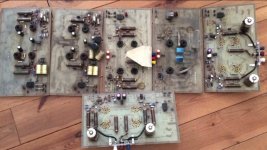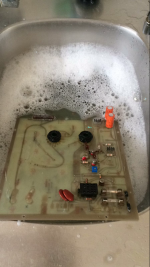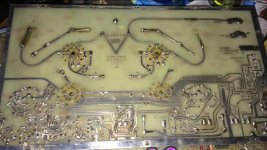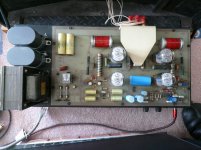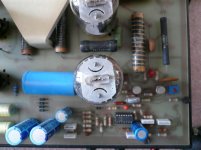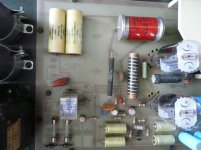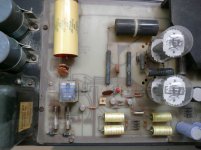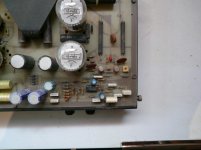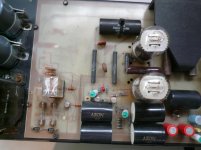ferrstein-
I see no issue (that is, it won't cause any damage) with re-arranging the segments in a Spectra speaker. My only suggestion is that it be done in such a way that you can return it easily to the original factory configuration. You may find you don't like the result.
As for your idea of using twin interfaces - that's way too complicated for my tastes, with dubious advantages. There's about a 100 ways that could go wrong after a lot of work to make it happen. Why put all that extra 'stuff' between you and the music?
Thanks Andy! I may try the reconfigure. I'm actually going to switch the speakers left to right but I suspect I don't want the full-range segment that close to the wall.
As for biamping... yeah. I'm just looking for a way to use all four channels of my fancy new DSP preamp.
The last time I heard a pair of Spectra speakers with left and right speakers swapped the effect was weird with a capitol W. Hard to describe, like the halves of my brain were trying to swap places. Uncomfortable! Your results may be different, no harm in trying.
Wait - did you remember to swap the speaker wires?
I ran this experiment last night. I agree with weird, but I also found it quite entertaining! Best way I could describe it is that I was listening to an exploded diagram of what the soundstage was supposed to be.
I listened to Nora Jones' debut album. She was 8 feet tall, and the sides of the soundstage were projected way forward while the center of the soundstage was projected way backwards. Highly entertaining but... yep... weird!
Anyway, that was fun! I may still try moving my full-range segment inboard but I'm starting to think Spectra 22s would be a better match to my room. I actually have a set of frames here so building them up for a listen should be rather easy.
Swapping between 120v and 220v is mostly done by changing the small mains transformer for the appropriate version, although external step up, or step down transformers can also be used.
I have a pair of 120v transformers (in New Zealand) that I would happily swap for your 220v transformers. Need to check postal costs to see if it is worthwhile though.
Cheers
Gn
I have a pair of 120v transformers (in New Zealand) that I would happily swap for your 220v transformers. Need to check postal costs to see if it is worthwhile though.
Cheers
Gn
Alternately, I suppose doubling the number of cap/diode stages would get you up to 5kV with the 220V transformers running at 120V. If DeltaStar doesn't take you up on the swap, I'm scheduled to have a pair of 220V transformers in a week I'd be interested in swapping if the postage is not ludicrous.
Andy, congratulations on your 10th anniversary of the Acoustat Answer Man thread! Thanks for all you have done to help keep our speakers alive. Long Live Acoustats!
Thanks to all for your comments - has it been 10 years already? Some may think it's a bit nuts providing "Customer Service" for a company where I last worked 30 years ago, but there was, and still is a need. Good 'ol Acoustats just keep on ticking, so we need to keep them running!
Andy, can you lend some insight on possible issues with two of my servo amps. I have the trouble shooting guide but it does not deal with, I'm hoping the obvious. I've got 4 hooked up with the same signal. One pair(consecutive #) exhibit not really the white noise described in the guide but more of a low key scratchy noise. It's not loud but I can just hear it at my listening position 12' away between tracks and until they go back into standby. Not after that. If I turn the volume pots back and forth quickly it's better/worse, louder/softer, popping, like a dirty pot. One of them goes quiet on full volume, the other somewhere lower. Just dirty pots? My concern is that it's in one of the 'pairs'. Both pairs have been rebuilt with better parts in the past but to spec and they are a bit different in terms of specific parts count. They otherwise function as they should. Curious pots would go bad simultaneously in the same pair. TIA
Low key scratch noise can be from the high voltage feedback resistors.
Do you have pictures of the amps so i can see what has been done on them?
Because of micro arcing there can be loss of conductivity on some HV parts causing crackling noises.
Also dust and humidity (especially this combination) can give problems here.
I had many amps to restore (some modified to death) and somethimes could save a set by cleaning them and replacing all vital components.
Do you have pictures of the amps so i can see what has been done on them?
Because of micro arcing there can be loss of conductivity on some HV parts causing crackling noises.
Also dust and humidity (especially this combination) can give problems here.
I had many amps to restore (some modified to death) and somethimes could save a set by cleaning them and replacing all vital components.
Attachments
Last edited:
Could this be the case even when the pots behave as if dirty? 1-3 is of one pair, 4-5 is the other. The last pic is of a non functioning 3rd pair
Attachments
Last edited:
If pots behave dirty then it will be gone while moving them a bit (or scratch when moving). I do not recall ever having a bad pot in any of these sets. The original pots are of great quality. That is why i think it is not likely. You mentioned the same behavior on both amps at the same time...
It sounds to me that it is caused by your preamp (source) not the poweramps. Can you test this first?
It sounds to me that it is caused by your preamp (source) not the poweramps. Can you test this first?
The first amp has the "old" HV resistors i have mentioned that will slowly die... the other amps use different (black) HV resistors (maybe already replaced). So it is unlikely that these show exactly the same issue at the same time.
Think about a common situation they share like a mains cable or as mentioned before the sources.
Do you switch them on/off manually or is the autoswitch circuit still in service (as it should! )?
Think about a common situation they share like a mains cable or as mentioned before the sources.
Do you switch them on/off manually or is the autoswitch circuit still in service (as it should! )?
- Home
- Loudspeakers
- Planars & Exotics
- Acoustat Answer Man is here
